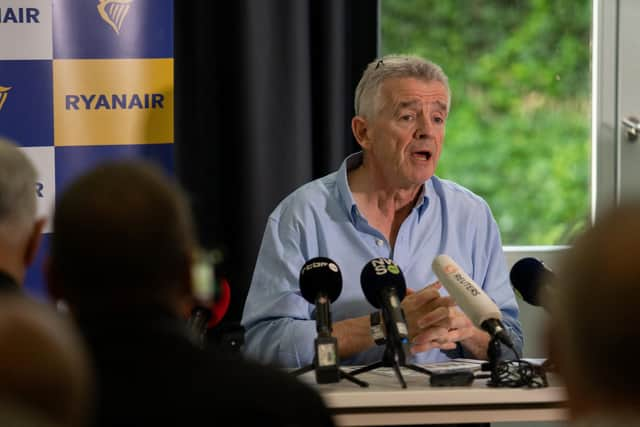Net-zero carbon emissions: Ryanair's Michael O’Leary may be optimistic about aviation but questions about industry's emissions are growing – Alastair Dalton
He said it was the most optimistic time he’d seen for air travel for the past 25 years, telling an event organised by air traffic co-ordinating body Eurocontrol: “Everybody's been locked down for two years. Tourism is getting back, hotels are filling up again, beaches are filling up again. Everyone's getting moving again.”
O’Leary’s confidence came on the same day that rivals Easyjet announced both a record summer performance and its intention to return to pre-Covid capacity by next year, despite potential turbulence from inflation and oil prices.
Advertisement
Hide AdAdvertisement
Hide AdRyanair, which this year has edged Easyjet off the number one spot at Edinburgh, Scotland’s busiest airport, has made a far better recovery from the pandemic, having laid off fewer staff and being able to more quickly ramp up flights as demand surged back with the easing of travel restrictions. It is now operating ten per cent more flights than before the virus struck.


O’Leary is champing at the bit to get more new, greener Boeing 737 Max aircraft delivered, which Ryanair has branded as a “game changer” because of its lower operating costs and emissions. But he said the airline would be lucky to have 40 by June rather than the 51 due by April, which would also significantly hold back its growth plans.
However, such aviation expansion comes with an obvious environmental cost in the face of the climate emergency declared by the Scottish and other governments. The development of alternatives to traditional aircraft fuel is still in its relative infancy, but this will become an increasingly discussed and significant consideration about flying.
The first step, waste-derived “sustainable aviation fuel” or Saf, is still only available in very limited quantities and costs around five times as much as traditional jet fuel. Alternative propulsion, such as using electric batteries and hydrogen, is still in its early testing stages, and can so far only carry a small number of passengers fairly short distances.
However, it might be nearer than you think, with Easyjet announcing the testing of a Rolls-Royce engine using hydrogen, the company having told me at the COP26 climate change conference in Glasgow last year that it wanted to be among the first airlines to be carrying passengers in an aircraft powered by the fuel, which could be as early as 2035.
Just as electric vehicles were talked up a decade ago, they are now becoming increasingly common to the extent that when a company contacts me to tout the latest such additions to their fleet, my immediate reaction is that it would be more newsworthy if they weren’t converting from petrol and diesel.
In time, the same will also become true of aviation. If an airline is not offsetting its emissions through verifiable means or using Saf when it becomes more widely available, or switching to electric or hydrogen, politicians and passengers will want to know why.
Comments
Want to join the conversation? Please or to comment on this article.